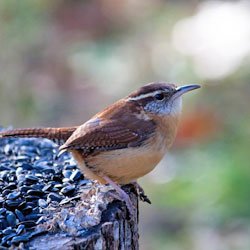Birds that will use nest boxes/birdhouses

Properly designed nest boxes will likely attract birds to nest in your yard. Review the information provided below about the preferred habitat of each species and try a nest box for the species most likely to be attracted to the type of habitat your backyard provides.
Bluebirds: To successfully attract bluebirds, their houses should be placed near an open area such as a field, orchard, park, cemetery, or golf course. They prefer nest boxes on a tree stump or fence post between three and five feet high. The entrance hole should be 1 1/2 inches in diameter. Either mount the house on a metal pole or install a predator guard on a wood post to deter predators such as snakes and raccoons. More information about Bluebird Boxes
Robins: Robins prefer to build their nests in the crotch of a tree, but they will also use manmade nesting platforms. Platforms are a good option if you have a new yard that lacks mature trees and shrubs. Place your platform six feet or higher up on a shaded tree trunk or under the overhang of a shed or porch.
Chickadees, nuthatches and titmice: Put chickadee houses at eye level, on a tree trunk. The entrance hole should be 1 1/8 inches in size to attract chickadees and exclude house sparrows. Nuthatch houses should be mounted on tree trunks five to six feet from the ground.
Wrens: Wrens are not very picky about where they nest. A nest box with a 1 inch by 2 inch horizontal slot instead of hole is suggested for wrens. Male house wrens build several nests for the female to choose from, so you may want to hang several nest boxes for wrens in your yard.
Brown Creepers and Prothonotary Warblers: In heavily wooded yards, slab bark houses may appeal to brown creepers, which naturally nest behind the curved bark of tree trunks. Prothonotary warblers also like slab bark houses, or bluebird houses attached to a tree trunk, but theirs must be placed over water (lakes, rivers or swamps) with a good canopy of trees overhead.
Tree Swallows: Tree swallows prefer nest boxes attached to dead trees. Space the boxes seven feet apart. The best location for these nest boxes is on the edge of large field near a lake, pond or river.
Violet Green Swallows: Violet-green swallows nest in the forested mountains of the west. Nest boxes placed on large trees in a partially open woodland will attract these birds.
Barn Swallows and Phoebes: You can encourage these birds to nest on your property with a nesting shelf on an open barn or old shed.
Purple Martins: The best location for a martin house is on the edge of a pond or river, surrounded by a field or lawn. Martins need an unobstructed flying radius of about 40 feet around their houses. Martins nest in groups, therefore a martin house should have at least four large rooms. Entrance holes should be 2 1/2 inches in size. Martin houses are elevated on poles 10 to 20 feet of the ground.
Flycatchers: The great crested flycatcher and its western cousin, the ash-throated flycatcher, are common in wooded suburbs and in rural areas with woodlots. Their natural nesting site is abandoned woodpecker holes. Flycatchers may nest in nest boxes placed about 10 feet high in a tree in an orchard or at the edge of a field or stream.
Woodpeckers: Only flickers are likely to use nest boxes. Flickers prefer a nest box with a roughened interior and a floor covered with a two inch thick layer of wood chips or coarse sawdust. Locate the box high up on a tree trunk, exposed to direct sunlight.
Click here for a table of recommended nest box dimensions by species
